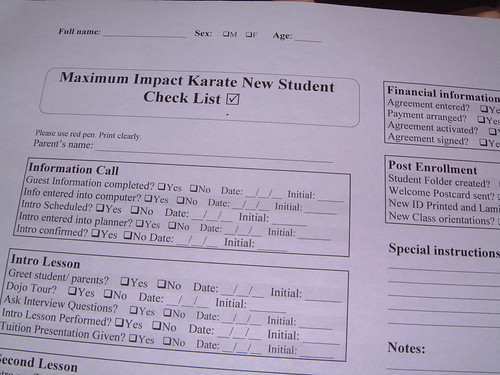 Once the evening rolls around, our karate school is buzzing with activity. Our kickboxing class is no exception. It appears like every other class with lots of students involved in a high energy workout.
Once the evening rolls around, our karate school is buzzing with activity. Our kickboxing class is no exception. It appears like every other class with lots of students involved in a high energy workout.
But, is it really like every other class? On the outside, yes but on the inside, no. I hope that this article will help other business owners understand when it's time to call it quits on a poor performing service or program. Also, non business owner, you can think in terms of time. For example, is getting that second job really worth the time?
Some tough questions to ask
Could I make more money with different class in the time slot? The kickboxing monthly tuition is almost half the tuition of the regular program. I think this says it all. I need to double the class size to make as much money as our regular program. Which takes us to question number two.
The kickboxing monthly tuition is almost half the tuition of the regular program. I think this says it all. I need to double the class size to make as much money as our regular program. Which takes us to question number two.How is the program retention?
The retention rate refers to how many people stay with the program each month. High retention rates means that students are stay with the program longer. The retention rate determines how many new students you need to grow the program. The average kickboxing student stays about three months while my karate students stay for years. Bottom line, we need to spend more money and time in marketing the kickboxing.
Are we spending marketing dollars on a program that would give a higher return in another area?
Any way you slice it, we need to divide our marketing budget between the regular program and the kickboxing program. Two marketing programs requires either splitting your efforts in half or spending double the time.
Is the program capital intensive?
Our kickboxing program required us to purchase expensive standing heavy bags and exercise bands.
Does the program provide the opportunity for addition retail sales?
No, once they get the initial equipment, they do not require anything else. The regular program provides the opportunity for addition retail sales and services.
Is there the ability to upgrade students to higher value programs?
No, the kickboxing program is a kickboxing program. I am not saying that you could not develop something, but for me, that takes time away from developing the karate program.
In the end, I believe the change is not only going to be good for the program and business but it will free up some more of my time.


 I read Leo's post called
I read Leo's post called 

